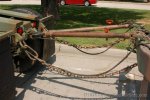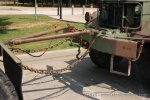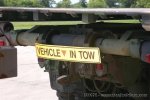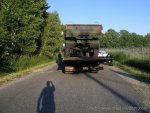Crossing safety chains is a big plus for most of the reasons listed, allowing tighter chains with more turning radius, catching the toungue (towbar) should it fall, guiding a flat towed vehicle behind the tow vehicle, preventing the entire "catch" of a fallen trailer toungue from landing on just one chain, etc.
Crossing tie down chains on a carried vehicle is not necessarily so. If it can be done, it's not a bad idea, the trouble is that you have to watch the angles of the chains. This often makes it impractical or downright dangerous to cross the chains. You can take what should be a 5,000 pound per chain tie down and turn it into a 50,000 pound tie down with just by changing the angle of the chain a bit. In this application, the actual act of crossing the chains accomplishes nothing. As Cdub's photo points out, the desired effect of "triangulaton" of the tie downs is easily accomplished without the crossing. If you took that same load, same four tie down points, but crossed the chains, the actual load applied to the chains in many expectable events would be greatly increased.
For a slightly different, yet remarkably similar example, look at how particular the instructions are for securing a shelter to a deuce. The cables are not to be crossed, not because the cross isn't just as directionally stable, but because crossing the cables causes an angle that signifigantly weakens the cable. The recommended "V" tie down gives a much better angle to maximize the strength of the cable.






